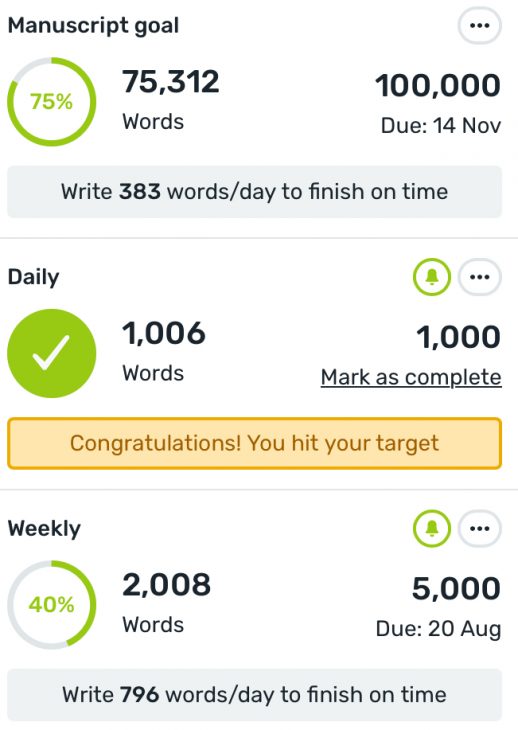Reedsy: From the Perspective of an Incorrigible Pantser

Good Evenaftermorn, Readers!
Those following along on my own personal blog know that I am waist-deep into a work in progress that I’ve titled The New Haven Incident. It’s a very silly premise – what if a zombie-style plague created hyper-aggressive fairy-types instead of the walking dead? – but I’m loving the characters trapped in this silly hellscape and I’m having an absolute blast writing it. Ordinarily, I don’t really use any tools to write save for a word processor. This time, however, I opted to give one of the many programmes a go to see if it would help my workflow at all. What a better WIP to try it with than something I’m going to offer free on my blog as a serial? So, after a little bit of research, which includes the phrase ‘free’ because I’m a writer and have no money, I settled on Reedsy.com.
Here’s what I think of it thus far.

I have tried, and failed, to find any use in many, many writing programmes in the past. They’re just not suited to the way I write. The problem is, I’m a pantser. An incorrigible, incurable, terrible pantser. Usually, when I sit down to write, I have only my main character(s) and the ending of the tale. How my characters get to that end is as much a surprise for me writing the first draft as it is for the reader reading the thing for the first time. I do not, by the by, recommend writing this way. While it is about as much fun as writing is capable of being, it does create so many issues for future me to wade through as I go through my first edit. The number of times I’ve used nonsensical placeholders for people’s names, or locations, or even entire events so I can continue writing the scene as quickly as my fingers will allow (my brain spews a lot of fictional nonsense at an alarming rate, and my fingers are forever playing catch-up) is absolutely atrocious. That results in a lot of back and forth through the manuscript while I try to figure out which person belongs where (like military units for example), or what exactly I was referring to in the moment during my first edit.
It’s not fun. 0 out of 10. Do not recommend.
I honestly wish I could be more structured, but I learnt a long time ago that my characters will take all of my carefully laid plot points, tear them into tiny, heart-breaking pieces of confetti, and throw that mess everywhere – all while looking at me dead in the eye, daring me to do something about it. To my credit, I did try once. That resulted in three months of writer’s block and a lot of frustrated tears. I learnt my lesson, and never again attempted to wrangle any story into the shape I envisioned at the beginning and just let the thing unfold as it would. Writing has gone much smoother since I implemented this policy.
My characters are hooligans.

For this reason, I was not hopeful when I signed up for a free account with Reedsy.com. Like all the other writing programmes out there, it really does favour the planner-type of writer. It already has a chapter divider, so I feel pressured to know precisely what happens each chapter. This is antithetical to how I write. I just write the whole damned thing in one long document and split up the chapters once everything is done. This helps me to fill in the places where things are missing so that the narrative makes sense as a whole. There really isn’t an option for someone like myself where you can simply write the whole thing in one great text block and then sort it into chapters.
I sometimes write scenes out of order as well, depending on which particular one is screaming the loudest in my head at any given time. I mean that almost literally. Imagine, if you will, the noisiest child on a round-about, screaming maniacally as the thing spins. The sound gets louder as the sticky-handed gremlin approaches and fades as it whips past. But it just. doesn’t. stop. It’s wailing like a damned emergency services siren over and over and over until you manage to catch the brute and pull it from the round-about. Which is to say, you write the damned scene. That’s the same level of persistent irritation that some scenes will deliver when I’m in the midst of writing a story.
For myself, this means that the current chapter divisions are all over the place in Reedsy at present. I’m kind of just sticking scenes where I think they’ll go in the overall narrative. Some chapters are the usual length I write them in (hovering around five thousand words; sometimes a bit more, sometimes a bit less). Others are obnoxiously long as I just spewed out the various scenes in order when I could. It’s going to take a little bit of reorganising while I’m doing my first edit, and it will be a little bit more complicated than me just inserting a page break as I would if I was only using a word processor. So, not an improvement over my previous method.

I do like, however, that they have many sections in the planning area of the programme in which you can write out and arrange scenes (not a feature I use because, well, I don’t know the scene until I’ve written it) and, better for me, a section where you can list your characters, settings, and historical events that are directly or indirectly referenced in the story. This will make figuring out who goes where in the editing go much more smoothly for me, as I won’t be scanning the text for the first mention of which particular team Oliver Mendez belongs to (for example). I do not, however, reference it while I’m writing, as that would interrupt the flow, so I remain using the idiotic placeholders I always use as I’m writing. It is an improvement on my usual process, but the improvement is pretty minimal. I say that now. It is very likely that I’ll be blessing the character bible gods when it comes time to edit the thing.
The best feature by far, though, and literally the only reason I’m still using Reedsy, even though it doesn’t really cater to pantsers as much as planners, is that it permits you to create and track various writing goals. For myself, I’m aiming for roughly 100,000 words (which is around about the usual number of words I write for any story) overall. Also included is the weekly goal of 5,000 words, and a daily goal of 1,000 words. It congratulates you as you reach each goal, and you can mark it as complete and set another goal. I do that daily and weekly. It really helps to create a sense of accomplishment, which is vital when writing something so long. It’s easy to get overwhelmed by the monumental number of the finished thing. Breaking it down into smaller targets really helps to keep the dark shadowy monster of overwhelm away. Plus, it’s a lot of fun to mark your progress.

This is something I have manually done until now, so it’s not technically an improvement for me. It’s just doing something with flashy graphics that I do with a pen and paper. Even still, I’m really enjoying this feature in particular, and it’s more than enough to keep me using the programme for this project. Perhaps for other projects as well. We’ll see.
That it’s only online is not great. If you decide to use it, be sure to download and save your work pretty regularly. They make it super easy to do – you just go to the export feature and scroll down. You’ll see a back-up option and it’ll send you a link. Click the link and bam! Offline back-up of your work.
In conclusion, I actually am really enjoying using Reedsy for my writing, even though I could achieve pretty much the same thing with nothing more than a word processor. Chances of me using it for future projects are pretty high, even if it’s only for the flashy tracking feature. I do feel that if you’re more of a plotter, you will get so much more out of this programme than I ever could.
Unless, for some unknown reason, my characters one day stop being such hooligans.
I hope this review was helpful for those looking for a free writing programme. I do recommend Reedsy, especially if you are a plotter. I’m having fun with it.
When S.M. Carrière isn’t brutally killing your favorite characters, she spends her time teaching martial arts, live streaming video games, occasionally teaching at the University of Ottawa, and cuddling her cat. In other words, she spends her time teaching others to kill, streaming her digital kills, teaching about historical death, and cuddling a furry murderer. Her latest novels are Skylark, Daughters of Britain, and Human.
James Scott Bell has a book on ‘Writing from the Middle’ of your story. He opens it with a great bit about Pam the Pantser. And follows it with the viewpoint of Paul the Plotter. Then Tammy the Tweener. Great fun! Thought you might like the Pantser part:
“Pam Pantser loves writing so much she’d do it even if she never got published or paid. Even if she never landed a contract or sold anything online. For her it’s about the writing itself––getting up each day and going wherever her imagination leads.
Of course, she’d actually like a little income from her writing. Who wouldn’t? She once tried to outline a novel. It almost killed her. Her wild writer’s mind kept fighting her, telling her she was actually hurting all that was good and lovely and true in her writing. She pressed on with the outline, but it was like shampooing a porcupine.
Then she read an article where some author said all outlining is bovine droppings (he used a different word) and anybody who tells you to use an outline is a fraud. This warmed Pam’s heart so much she ditched her outline and entered NaNoWriMo with only a wing and a prayer. One month later she had what she called a “novel.” But when she looked at it in January she couldn’t make out what kind of novel it was. She showed it to one of her best friends in the world, Cathy Critique. Cathy actually took Pam to lunch and insisted on paying. Because she had to tell Pam that, while there were some beautiful paragraphs and lines, the story was dull, unfocused, meandering and, to put it bluntly, “a mess.”
“I know that!” Pam said. “But I’m a pantser! What am I supposed to do? I can’t outline to save my life! Am I doomed?”
Cathy, even though insisting Pam have an entire chocolate soufflé for herself, had no answer for Pam.
But I do.”
Oh, I am absolutely Pam the Pantser! Except I feel like my stories, once finished, aren’t nearly so much of a mess. They just need some extra care in editing…
Bell has some good books on writing. And he’s got a good sense of humor. Here’s the Paul Plotter portion:
“Paul Plotter could build you a bridge across a gorge. His mind is a steel trap, a Rubik’s Cube, a filled-out crossword puzzle. He can map out a story like Lewis and Clark charting the Louisiana Purchase. His outlines have a perfect three acts, The Hero’s Journey in all its glory, and hit every mark on the Blake Snyder Beat Sheet. He has self-published nine thrillers, all of them getting reviews like, “Pretty darn good” and “Nicely paced.”
But none of his novels have taken off. He can’t figure out why.
He has tried to emulate James Patterson. He heard once that Patterson works (or at least used to work) from outlines that are sometimes eighty pages long.
Paul’s outlines are works of art, and if there was a market for outlines he’s pretty sure he could make a living as a writer.
And you should see his character backgrounds! The man writes page after page of backstory for his main characters, and even fills out questionnaires on his minor ones. In fact, Paul likes to carry around a fat binder full of all his pages of outlining, character work, and research. He likes it when people at Starbucks ask him what’s in the binder. He can talk for hours on the benefits of outlining.
But somewhere between complete outline and finished novel, something doesn’t jell. For some reason, Paul’s perfectly plotted stories don’t catch fire.
He’s read a million words of craft advice, taken classes live and online. He knows his stuff, but doesn’t know how to take it to the next level.
I’m going to help Paul.”
Well… I’m sold. I might have to get this book.
The next piece is Tammy Tweener (I think), who bridges a path between the two approaches.
Bell wrote a series of Pulp-style short stories featuring a movie studio problem solver (an homage to W.T. Ballard’s Black Mask stories about Bill Lennox) which I really liked. My favorite thing of his.
He’s got about two dozen books on writing. I know I learned some things from his Plot and Structure book when I got it years ago.